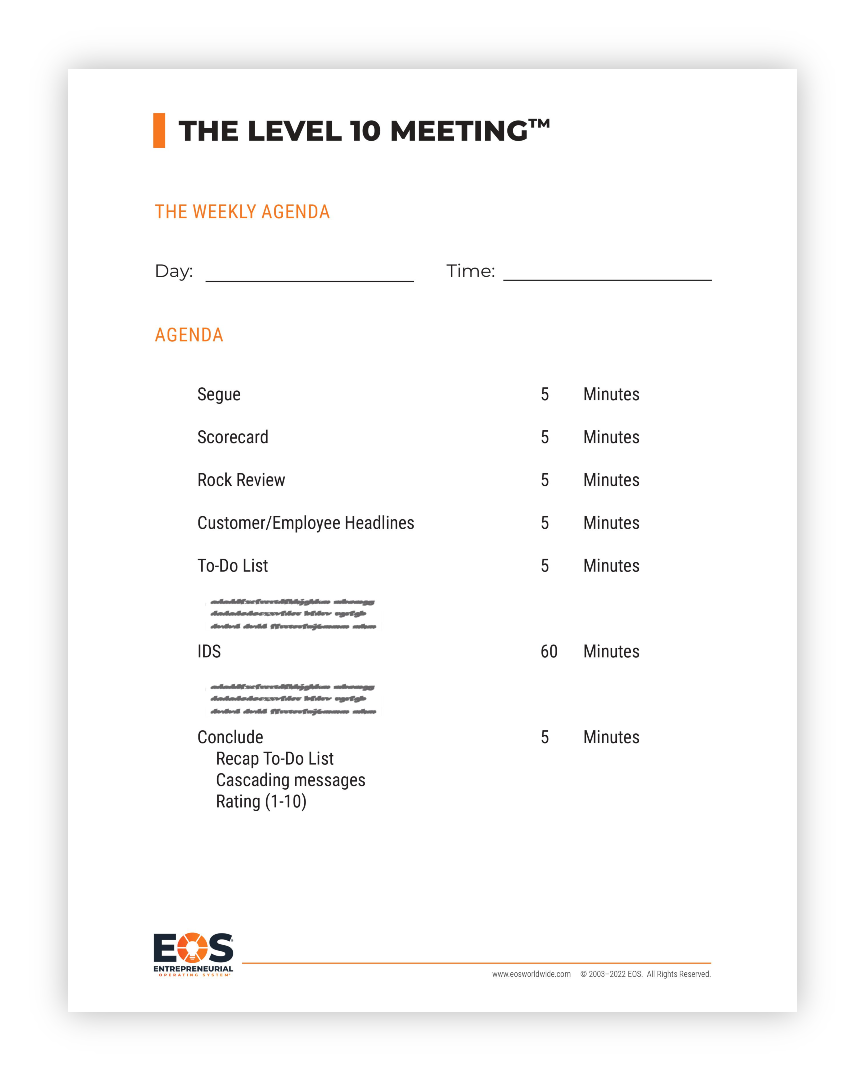If you’re already using EOS or know about the tools, you probably get what the L10 meeting is all about. But if you’re new to this, the L10—or Level 10 meeting—is a structured and effective way to improve how your organization talks and solves problems. L10s are part of a regular meeting schedule with employees within specific departments, and offer opportunities to discuss company happenings and tackle challenges.
Under the L10 meeting, each individual has measurables, and the meeting adheres to a structured agenda. At the end of each meeting, all participants, regardless of their role in the company, rate the meeting’s effectiveness and suggest ways to make the next meeting even more productive.
Once the organization’s leadership team has a consistent L10 meeting rhythm, they’re tasked with something even greater: cascading the L10 down to the rest of the organization. Finding the time to make sure you and your teams are satisfied can be tough, but it’s not impossible. Being open, responsible, and working together to make decisions are the foundation of the L10. This doesn’t just mean having L10s at different levels; it’s also about making sure everyone is on the same page and talks openly. The goal is for every team member to see how they help the company reach its goals and feel good about sharing their thoughts and ideas.
If you’re anxious about cascading L10s to your team, you’re not alone. I chatted with Brendan Bolhuis, the integrator at Beacon Recycling, about how they cascaded their L10 down to their recycling truck drivers. Here are some of his insights, having gone through that process with his team.
“What if we can’t find a time that works?“
To make sure you can fit an L10 meeting into your team’s busy schedules, work together to find a time that works for everyone (or nearly everyone, if there are extenuating circumstances). It might mean having the L10 first thing in the morning or right after lunch, but it’s important to prioritize the L10.
This meeting is crucial because it’s a time when team members, managers, and even the leadership team come together to define and solve problems. While the traditional L10 meeting is 90 minutes, that isn’t always necessary! In Brendan’s case, his truck drivers meet at the very beginning of their shift—an early start at 5AM—for a 15-minute L10 each week. If your team cannot allocate 15 minutes in their day for a meeting, it may indicate an underlying issue that requires attention.
Effective workplace time efficiency promotes unity between your team and management. This commitment to efficient communication and collaboration becomes strikingly apparent during the results and discussions of a regular L10 meeting where everyone is present.
“I’m worried it’ll turn into spewing negativity.”
Many leaders are worried that the L10 will turn into a town hall-like meeting where everyone on the team just comes to air their grievances to their managers. They might also worry that those problems will add significant work to their plate. On the contrary, it’s often other members of the team who can provide solutions to issues that come up!
Effective communication is all about making sure information and ideas flow smoothly between people. It’s not just about the leadership team finding answers. In the L10, all employees can share their insights and practical solutions to challenges based on their personal experiences without involving the leadership team. It gives team members the chance to say, “I get it because I’ve been through it, too. Here’s how I handled it.” This can create a more cooperative and trusting environment by encouraging your team to share their personal experiences, especially if they’ve faced similar challenges.
“I don’t think my team will benefit from the L10.”
These meetings aren’t for sitting quietly and listening. They require active communication, speaking up about concerns, and taking accountability for shortcomings. The L10 is designed to hold your team accountable to what they said they’d do, and provides a structured format to tackle any issues that arise. Dedicating time for that, alone, is a huge benefit to your team.
Another way your team will benefit is through greater trust. In the L10, team members see the management or leadership teams listening to current issues, but it doesn’t stop there. This shows employees that A) the leaders are aware of their problems, B) they’re working on a plan to solve them, and C) there’s someone responsible for making sure it happens.
That open communication and follow-through, over time, creates much more trust in your organization. Eventually, your team will feel comfortable enough to bring up smaller issues early, well before they turn into a real problem.
Communication is the Cornerstone of Leadership
Even if you feel uneasy about extending the L10 to your entire team, remember that being able to effectively pass on information from top to bottom (and bottom to top!) is vital for growth. As Brendan pointed out in his interview, when someone brings up an issue in the maintenance team’s L10, he makes sure it gets to the right management level because tackling those issues is necessary to their success. And making sure everyone speaks up—and is heard by the leadership team—is crucial.
You don’t need an official title to show leadership qualities. This is the kind of attitude that someone on your management team should convey to everyone else. L10 meetings offer a platform for your team to express their opinions, help one another, improve their skills, and gain leadership experience. Keeping a record of L10 meetings is vital for business growth. It empowers employees to step into leadership roles and be responsible for their thoughts and opinions, which is crucial for building a united and successful team.
Have questions? I’m the only Scott Patchin on the internet, so I’m pretty easy to find! Either connect with me on LinkedIn, or shoot me an email to scott.patchin@eosworldwide.com.

